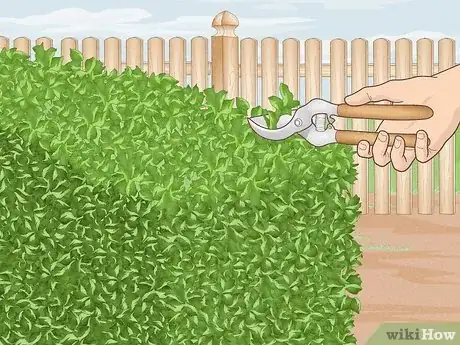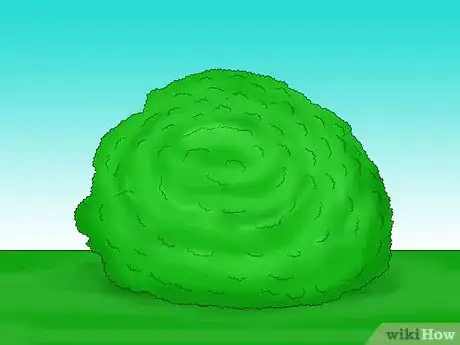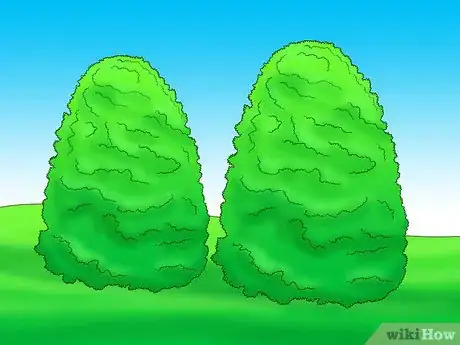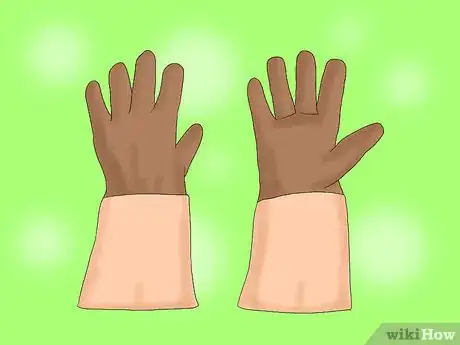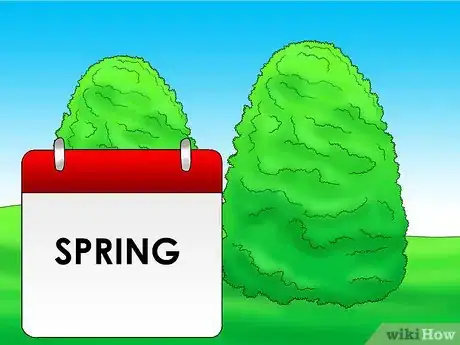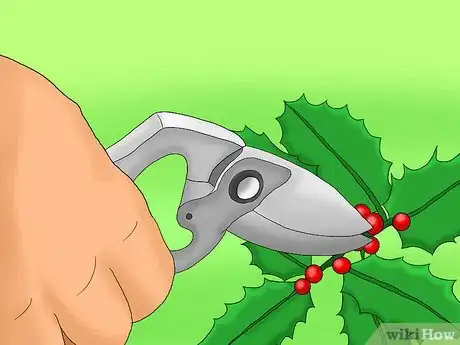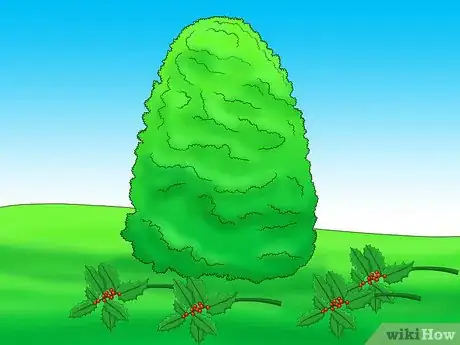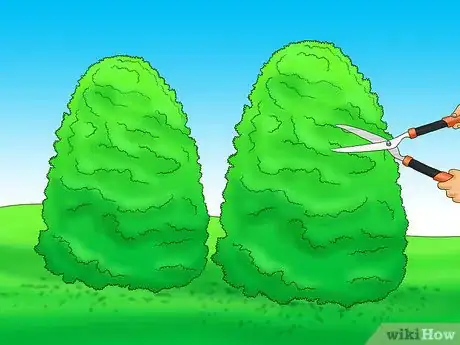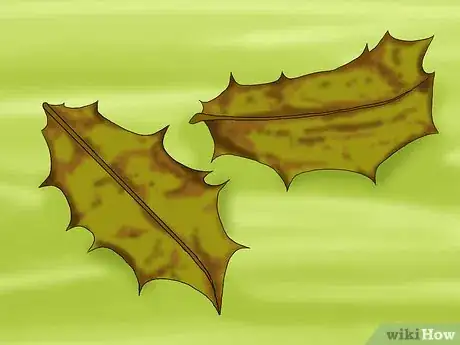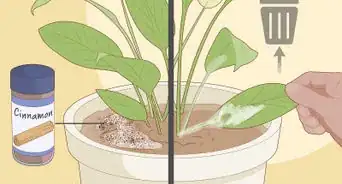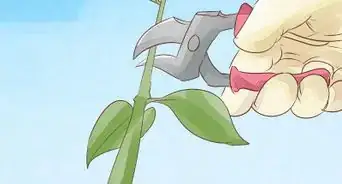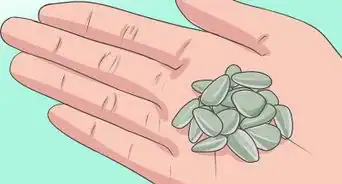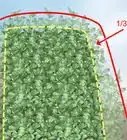This article was co-authored by Katie Gohmann. Katherine Gohmann is a Professional Gardener in Texas. She has been a home gardener and professional gardener since 2008.
There are 11 references cited in this article, which can be found at the bottom of the page.
wikiHow marks an article as reader-approved once it receives enough positive feedback. In this case, several readers have written to tell us that this article was helpful to them, earning it our reader-approved status.
This article has been viewed 235,904 times.
Holly is a popular and decorative garden plant which ranges in size from 2 to 40 feet (.6 to 12.1 m). Though it's generally a low-maintenance shrub, you will need to prune your plant in order to keep its size under control and to promote the growth of lateral buds and shoots.[1] The way you perform this upkeep depends on the particular type of holly you have: while some holly requires only moderate pruning in the first few years of growth, other kinds need a more vigorous pruning regimen.[2]
Steps
Preparing to Prune
-
1Master the basics of pruning. It's not rocket science, but pruning is a bit more complicated than it looks. There are different techniques of shaping and specific places on the shrub where you should make the cuts, so don't just start chopping. Before you get started, take a minute to review the fundamental terms and concepts pertaining to pruning.
- Shearing is the act of maintenance where you simply trim the outermost twigs to control length. Thinning is where you cut and remove branches throughout the shrub.
- Thinning is generally preferred over shearing, as exclusively shearing will encourage dense growth on the outer edges of the plant and keep sunlight from getting to inner branches. This can create a transparent or hollow look which is considered less desirable than a full, even growth.[3]
- A terminal bud grows at the tip of a branch, and it sends hormones back down the rest of the shoot which inhibit the growth of other buds. This is why you want to prune: you want to clip off terminal buds in order to stem the flow of growth-inhibiting hormones and encourage growth of other, non-terminal buds.[4]
- A lateral bud sprout along the side of the shoot. When cutting, you want to cut back to a lateral bud node, which is the place on the stem where the lateral bud attaches to the shoot.[5]
-
2Figure out what kind of holly shrub you have. There are many different kinds of holly, such as American, Chinese, Japanese, Inkberry, Yaupon, and Winterberry, and these different types all have different needs.[6] You'll need to identify what kind of plant you have before you pick up the shears.
- If your holly plant loses its foliage every winter, it's a deciduous holly. These holly plants require radical pruning every year.
- If your holly plant never loses its foliage, it's an evergreen. These types of holly require more attention in the first few years of life but not as much thinning or shaping as time goes on.
Advertisement -
3Look at the natural shape of your holly. There are different kinds of evergreen hollies, and you should look at their natural shape in order to determine specifically how to prune them. There are pyramidal, rounded, and indeterminate holly plants.
- For rounded hollies, you should thin during the first few years and do formal shaping throughout its life. Pyramidal hollies require similar thinning regimens but little if any formal shaping throughout life. Indeterminate hollies need both throughout life.[7]
-
4Get the right shears and gloves. You can use any type of sturdy gardening gloves to protect your hands, but you should take a look at your holly branches before deciding on which shears you should use. This is because the size and circumference of the branches determine which kind of cutting implement you should use.
- Pruning shears work well on twigs and branches measuring 1/2 inch (1.3 cm) in diameter or less. A quality pair of lopping shears can cut branches measuring up to 2 inches (5 cm). Make sure to use ratchet-style pruners and avoid anvil-style.
- Larger limbs and branches may require the use of a pruning saw.
-
5Wait for the right season. There are times that are better for pruning your holly plant, as they take advantage of the plant's natural dormant phases and help the plant heal more quickly. It's a fairly sturdy and resilient plant, though, so don't worry too much if you have to prune in a sub-optimal season.[8]
- The best time to prune a deciduous holly is in spring as it produces optimal berry growth.
- For evergreen hollies, prune in the dead of winter when they're dormant – try pruning in December and using the branches as a holiday decor.[9]
- Tend to holly shrubs that are diseased or have broken wood as soon as you recognize that the shrub has health issues.
Thinning and Shaping
-
1Identify any branches jutting out from the bush. Long offshoots need to be cut back entirely or simply shortened to keep the shrub's shape. In general, take your pruning cues from the holly's natural shape. Also keep upper branches shorter than lower ones in order to ensure that sunlight can reach the lower branches.[10]
-
2Make the cut in the right place. Only cut directly above a lateral bud, rather than haphazardly in a mid-section of the branch or twig. Also, be sure to make angled cuts so that water can drain off the wounds.[11]
- If you disregard this principle and leave stubs from the places where you've cut, the stubs will heal more slowly. It also leaves the plant more susceptible to insects and diseases.
-
3Remove some branches completely. Cut branches off at the main branch or an intersecting branch in order to thin out the bush and create a more even distribution of branches throughout the shrub. Be sure to cut strategically: cutting far back into the shrub means that future growth on that site is unlikely, as older wood does not regenerate as easily as new wood.
- Pruning intersecting branches at their union will help you create a more organized framework of branches. This gives the shrub a nice, natural shape which needs minimal pruning later.[12]
Maintaining Healthy Growth
-
1Clean pruning tools. Be sure to use denatured alcohol if pruning a dying or diseased holly shrub. This is necessary because pruning tools can spread disease among to other plants or to different, healthy parts of the same plant. Disinfecting your tools will help you avoid this contamination.[13] Otherwise, clean tools with soap and water before putting them away.
- In addition to rubbing alcohol, you can also use a solution made from pine oil cleaner, household bleach, or ammonium salts. Soak your tools in the solution for at least five minutes, and then rinse with water.[14]
-
2Prune hedge shrubs yearly. While large holly shrubs rarely require pruning, shrubs used as hedges need to be trimmed yearly to keep a clean silhouette and shape.
- Shear along the surface of leaf growth to make sure the cut is even. Perform regular trimming by cutting the outermost twigs to the nearest bud node.[15]
- If your holly shrubs do not function as hedges or formal decorative pieces, allow them to grow naturally.
-
3Keep an eye out for symptoms of disease. When you spot any signs of disease or damage from weather, eliminate the affected portion by cutting it off several inches below the damaged portion.[16] You should do this as soon as you notice problems, regardless of whether or not it's pruning season.
- Open up the shrub with thinning cuts if you have disease issues, in order to promote air circulation.
- Several different types of root rot affect holly shrubs, so look out for yellow spots on the leaves, dark black roots, and stunting as common symptoms of these problems.
-
4Look for insect activity. Several types of pests such as scale, mites, and leaf miners harm holly shrubs and should be taken care of at the first sign of a problem. Again, disregard seasonal considerations and take care of it before the infestation gets worse.[17]
- The most common signs of infestation are discoloration, trails, or speckling on the foliage.
Expert Q&A
Did you know you can get expert answers for this article?
Unlock expert answers by supporting wikiHow
-
QuestionCan you resize a holly bush that has become leggy inside of the shrub?
 Katie GohmannKatherine Gohmann is a Professional Gardener in Texas. She has been a home gardener and professional gardener since 2008.
Katie GohmannKatherine Gohmann is a Professional Gardener in Texas. She has been a home gardener and professional gardener since 2008.
Professional Gardener
-
QuestionCan a holly be trimmed midsummer?
 Community AnswerYes, hollies are sturdy plants so they can generally withstand pruning at any time of year. It's best to wait until the dead of winter when they're dormant, but your holly should be okay if you must do a midsummer trim.http://aggie-horticulture.tamu.edu/earthkind/landscape/proper-pruning-techniques/
Community AnswerYes, hollies are sturdy plants so they can generally withstand pruning at any time of year. It's best to wait until the dead of winter when they're dormant, but your holly should be okay if you must do a midsummer trim.http://aggie-horticulture.tamu.edu/earthkind/landscape/proper-pruning-techniques/ -
QuestionHow do you preserve cut holly bush for decoration?
 Community AnswerAfter cutting, soak the holly in water overnight in order to keep them hydrated. After they dry out, douse them in a commercial spray that preserves holly and makes it fire-resistant. These anti-transpirant sprays, such as Wilt-Pruf, are widely available at home goods stores. Hang the branches and berries out of the sunlight and away from heat sources in order to minimize the risk of fire. Plan on changing out your decorations throughout the holiday season as the hollies will eventually dry out.https://www.clemson.edu/extension/hgic/plants/pdf/hgic1753.pdf
Community AnswerAfter cutting, soak the holly in water overnight in order to keep them hydrated. After they dry out, douse them in a commercial spray that preserves holly and makes it fire-resistant. These anti-transpirant sprays, such as Wilt-Pruf, are widely available at home goods stores. Hang the branches and berries out of the sunlight and away from heat sources in order to minimize the risk of fire. Plan on changing out your decorations throughout the holiday season as the hollies will eventually dry out.https://www.clemson.edu/extension/hgic/plants/pdf/hgic1753.pdf
Warnings
- Refrain from using paints or wound dressings to cover the cut portions of the holly shrub. They may aid in moisture retention and cause additional disease within the plant.⧼thumbs_response⧽
- Don't bring holly berries into the house if you have young children or inquisitive pets. Though plump and enticing, these berries can be toxic and should not be ingested.[18]⧼thumbs_response⧽
Things You'll Need
- Pruning shears
- Lopping shears
- Pruning saw
- Denatured alcohol
- Gardening gloves
References
- ↑ http://extension.uga.edu/publications/detail.cfm?number=B961
- ↑ http://garden.org/learn/articles/view/2095/
- ↑ http://extension.uga.edu/publications/detail.cfm?number=B961
- ↑ http://www.sunset.com/garden/garden-basics/identifying-growth-buds
- ↑ http://homeguides.sfgate.com/difference-between-tree-node-bud-39049.html
- ↑ http://www.gardeningknowhow.com/ornamental/shrubs/holly/common-types-of-holly.htm
- ↑ http://www.finegardening.com/pruning-hollies
- ↑ https://www.thespruce.com/when-is-the-best-time-to-prune-holly-2132691
- ↑ http://www.gardensalive.com/product/relaxing-the-rules-for-holiday-holly-pruning/you_bet_your_garden
- ↑ http://homeguides.sfgate.com/trimming-holly-bushes-41373.html
- ↑ http://extension.uga.edu/publications/detail.cfm?number=B961
- ↑ http://www.finegardening.com/pruning-hollies
- ↑ http://baker.ifas.ufl.edu/Horticulture/documents/DisinfectingPruningTools.pdf
- ↑ http://baker.ifas.ufl.edu/Horticulture/documents/DisinfectingPruningTools.pdf
- ↑ http://www.finegardening.com/pruning-hollies
- ↑ http://extension.uga.edu/publications/detail.cfm?number=B961
- ↑ http://www.gardeningknowhow.com/ornamental/shrubs/holly/diseases-of-holly-bushes-pests-and-diseases-damaging-holly-bushes.htm
- ↑ http://www.gardensalive.com/product/relaxing-the-rules-for-holiday-holly-pruning/you_bet_your_garden
About This Article
To prune holly shrubs, it’s best to wait until Spring when your plant will heal much quicker. Cut any long offshoots to maintain the general shape of your shrub. Make sure your cuts are angled, which will help them heal and drain. You should also cut directly above a lateral bud, instead of in the mid-section of the branch. To thin your bush, cut off a few branches at the stem, but keep in mind that these branches are unlikely to grow back. Try to prune your holly shrub once a year to maintain its shape. For more tips from our Gardening co-author, including how to spot disease and infestation of your holly shrub, read on!
